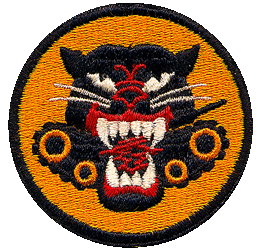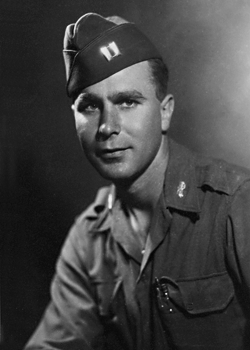 Baker D. Newton
Baker D. Newton
The following tribute was researched and written by Lowell Silverman. Lowell came across Cpt. Newton while doing research on his grandfather, Dr. Robert Silverman, who served at the 32nd Station Hospital.
Biography: Baker D. Newton was born on December 25, 1918 in Boydell, Arkansas. He was the twelfth child of Frederick and Mary Newton. During the next few years, the family moved to Louisiana and then Oklahoma, before finally settling in Ferriday, Louisiana.
Newton was an R.O.T.C. cadet while studying at Louisiana State University before the war. After finishing his undergraduate degree in 1940, he remained at L.S.U. for another year, obtaining his M.S. in Physical Education in 1941.
Service Time: According to his military records, 2nd Lieutenant Newton was commissioned as an 2nd lieutenant in the Infantry Branch on May 21, 1941. He went on active duty in the U.S. Army on August 25, 1941 and was assigned to the 94th Anti-Tank Battalion, which became the 894th Tank Destroyer Battalion shortly thereafter. By December 25, 1941, he was a platoon leader in Company “C” of the 894th Tank Destroyer Battalion; his name appeared in a program for a Christmas dinner the company held that day.
Curiously, on May 11, 1942, he was ordered to attend School for Bakers and Cooks at Fort Benning, and on May 23 he received a Certificate of Proficiency attesting to his fitness to serve as a mess officer. However, his records do not give any indication that he ever served in that capacity.
On June 4, 1942, Lieutenant Newton began attending Tank Destroyer School in Gatesville, Texas (near Camp Hood). A few weeks later, Newton came down with gastritis. After three days stuck in his quarters, he slipped out the night of June 17, 1942 to visit his brother in nearby Waco. Unfortunately, his conditioned worsened and he ended up hospitalized at the Station Hospital, Waco Army Flying School. Afterward, the 894th’s C.O., Major Allen H. Foreman wrote a letter to the Tank Destroyer School Commandant, Colonel H.T. Mayberry, apologizing for Newton’s “undisciplined act”. However, Newton was promoted to 1st lieutenant effective June 20, 1942 and graduated from Tank Destroyer School on June 30, so it appears his mistake didn’t impact his career!
Tank Destroyer School Certificate
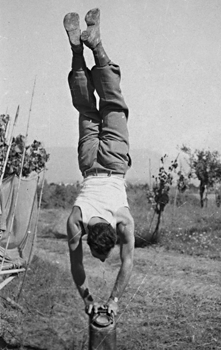
Lieutenant Newton went overseas with the rest of the 894th Tank Destroyer Battalion on August 6, 1942. Although he had moved between various assignments within the battalion, on December 27, 1942 he returned to Company “C” as executive officer under Captain Noble H. Abney.
On left, Captain Newton can be seen doing one of his famous handstands in August 1944, southwest of Pisa. In a November 25, 1967, letter to Newton’s widow, one of the 894th’s officers, William C. Long, recalled: “He was always in good spirits and constantly amazed the rest of us by his perfect handstands. I know his junior officers and enlisted men all thought a great deal of Baker.”
The 894th arrived in Oran, Algeria in mid-January 1943 and traveled east to Tunisia. The unit’s baptism by fire occurred at the Battle of Kasserine Pass on February 20, 1943. In a September 12, 1943 letter to his family, Newton recalled his company’s first time in combat. A few miles from the front, Company “C” was leading the 894th when they began encountering demoralized American infantry heading the other way. Soon after, three enemy armored cars approached.
“Then all hell broke loose from our guns – – all firing too hastily. We hit one of them, the others escaped back into the pass. By this time we were taking somewhat of a shellacking from artillery and machine guns which had moved along the sides of the valley on our flank.”
Newton wrote that that Captain Abney ordered the company to retreat. During the withdrawal, the driver of Lieutenant Newton’s halftrack
“couldn’t hear me very well above the noise, so after I yelled, ‘Left,’ about a dozen times, with no results, Jerry helped out. He tossed an H.E. [high explosive] right in front of us. Said driver turned left so damn quickly then he almost threw me out.
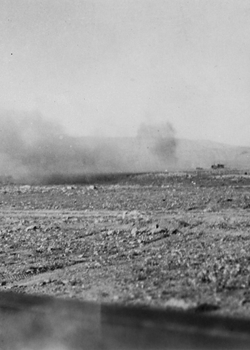
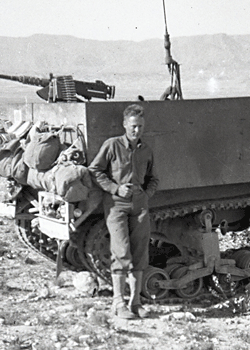
In the photo above left, Company “C” vehicles are under artillery fire during the Battle of El Guettar in this view from 1st Lieutenant Newton’s halftrack; the caption he wrote indicated it was taken the same day he earned the Silver Star Medal. On right, Newton standing with his command halftrack, in North Africa, Colena.
On February 27, 1943, Captain Abney transferred out of the company and 1st Lieutenant Newton took command of Company “C.” Newton was later awarded the Silver Star Medal for his performance during the Battle of El Guettar in April 1943. The citation, dated June 21, 1943, documented several exploits. The citation stated that during an artillery bombardment, “he went from foxhole to foxhole distributing magazines and joking with his men”. Then “he established an observation post” under heavy fire, which resulted in the silencing of an “enemy artillery battery.” (This may be the same incident for which Technician 5th Grade Leon Bush was posthumously awarded the Silver Star.)
When one of the unit’s M-3 tank destroyers was hit, Lieutenant Newton helped lead the effort to extinguish the fire: “Small arms ammunition was exploding while he assisted in putting out the fire by shovelling [sic] sand.” (Lieutenant Joseph R. Uhler must also have assisted, since his own Silver Star citation documented the same event.)
In a June 29, 1943 letter, Newton told his mother that while he was enclosing a copy of the citation, “don’t believe all it says. I’m not foolish enough to distribute magazines during a barrage – only during the breaks.” A May 17, 1943 letter also gave his men the credit for putting out the fire despite the danger of flames impinging on the load of ammunition (as well as the fact that the enemy artillery might be zeroed in on “the beacon-like fire.”). “Do you wonder that I am proud of my boys?” he wrote.
Newton’s daughter recalled that her father had a sixth sense, one that evidentially served him well in combat. In the May 17, 1943 letter, Newton recalled a
“time my 1st Sgt. [Clabe Sherman] was digging a fox hole and was only about half thru. I was sitting in my vehicle and I felt that something was wrong. I yelled to him to get down in his hole. He looked at me as tho I were nuts. There was no apparent reason to fear anything, but he did lie down and, Boy, they laid it on thick with artillery just as he dropped down. My men think I’m psychic. I call it blind luck, but even I don’t know why I told him to get in his fox-hole.”
Newton was promoted to captain on May 3, 1943, shortly before the Tunisian campaign ended. The 894th Tank Destroyer Battalion led Allied forces into Bizerte on May 7, 1943. Together with the capture of Tunis the same day, Axis forces remaining in North Africa were forced to surrender.
It did not escape Newton that the 894th Tank Destroyer Battalion was not being utilized as Army planners originally intended; in both Tunisia and Italy, combat against enemy armor was more the exception than the rule. In his letter home on May 17, 1943, he grumbled:
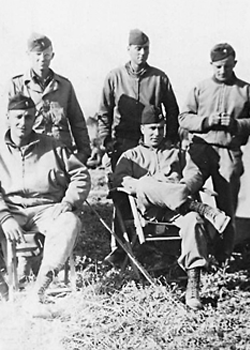
“I’d like to be back at [Camp] Hood, so I could tell the brass hats what we need. They’re preparing us to fight one way. We are used by higher authorities in every other way. Can you imagine a T.D. Bn. being the first troops into Bizerte? S’truth. ‘I seen ’em when they done it!’”
On left, Company “C” officers in Italy circa January 1944. Standing left to right: 2nd Lieutenant Thomas G. Wright, Jr., 2nd Lieutenant Herbert M. Siercks, and 1st Lieutenant Joseph R. Uhler. Seated left to right: 2nd Lieutenant Wesley J. Schmidt and Captain Baker D. Newton. Photo from the Uhler Family Collection.
At the end of May 1943, the 894th Tank Destroyer Battalion arrived at the Fifth Army Tank Destroyer Training Center near Sebdou, Algeria. There, the unit began converting from M-3 to M-10 tank destroyers. In early November 1943, the unit arrived in Naples and performed military police duties prior to returning to combat in December near Monte Cassino (mostly in the capacity of self-propelled artillery).
On January 9, 1944, Company “C” was withdrawn in preparation for Operation Shingle. On January 25, 1944, Captain Newton and most of his company arrived at the Anzio beachhead. Company “C” spent much of the Anzio campaign supporting the British 1st Infantry Division.
Late on February 3, 1944, German forces launched an attack intended to destroy Allied forces occupying the Campoleone salient. On the morning of February 4, Captain Newton withdrew his company to new positions near the base of the salient at Carroceto (just west of the town of Aprilia, better known as “The Factory”).
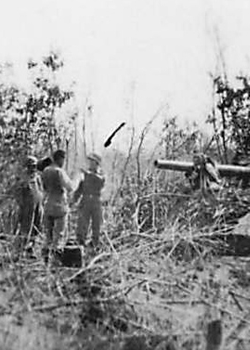
According to the S-3 (Operations and Training Officer) Periodic Report written by Captain Paul A. Baldy (1918–2008) covering the afternoon of Feb 3 through the afternoon of Feb 4, 1944:
“The enemy counterattacked very strongly during the period. ‘B’ & ‘C’ Companies participated very actively in repulsing the attack. ‘C’ Company destroyed four (4) Mark VI [Tiger] tanks. These have been confirmed by the British. One towed AT gun was destroyed while its crew was attempting to get it into firing position. Two destroyers held off the German infantry with their 50 cal. for two hours. Many casualties were inflicted. We lost two M 10’s–destroyed and one captured in this action. Two enemy occupied houses were also fired into by ‘C’ Company.”
On left, Captain Newton (marked) directing his men at Anzio next to one of the unit’s dug in M-10 tank destroyers. Photo from the Uhler Family Collection.
During the day’s engagements, Company “C” sustained casualties of five men wounded (all from Sergeant Eugene K. Holsonback’s M-10, which was knocked out moments after destroying one of the Tigers) and seven missing. (Of those M.I.A., it was subsequently learned that 1st Lieutenant Wallace C. Forbush and Private First Class Horace S. Millsaps had in fact been killed in action; Private First Class Anthony R. Paluzzi was taken prisoner but was subsequently killed when Allied aircraft attacked a German train he was being transported aboard.)
In a February 5, 1944 article by Daniel De Luce of the Associated Press—printed in various versions nationwide the following day—Captain Newton was quoted at length about the actions of his men during the counterattack, which he described as “the roughest time we have had since Tunisia”. He added:
“‘Before yesterday we already were credited by the British with one Tiger, three Mark IV’s, six anti-tank guns and 80 prisoners. My men were stationed with infantry outposts and when the Germans started overrunning these we fought back with everything we had. Our destroyers wiped out so many machine-gun nests yesterday that they lost count.’”
Trenton Evening Times – February 28, 1944
In the article listed above, Captain Baker D. Newton is shown with one of his platoon leaders at Anzio, 1st Lieutenant John S. Jarvie (whose name is misspelled in the clipping). Jarvie was killed during the breakout from Anzio on May 29, 1944.
Captain Newton had a close call during the Anzio campaign that wasn’t directly related to enemy action. On February 13, 1944, he wrote his mother:
“I am still in good health and as yet unscathed, tho I can’t say unscented. I haven’t had a bath in so long, I feel like it’s natural—this ‘sun tan’ of mine, tho even it turned white when those three British soldiers opened up on me at about 30 yards with tommy guns. It was all a mistake, of course, my helmet made me look like a gerry and I was standing in the window of a house we had just captured a few minutes before these British soldiers came up. Believe me I now take my helmet off to all those lads.”
Captain Newton was transferred from Company “C” to Headquarters Company on March 31, 1944. Shortly thereafter, he was transferred to VI Corps Headquarters. After a brief stint there, sometime in April 1944 he was transferred to the 805th Tank Destroyer Battalion, where he took command of Company “A” effective July 15, 1944.
He narrowly escaped death again south of Bologna according to a letter he wrote his sister, Hazel, on December 29, 1944, thanking her for sending all the film she had sent him:
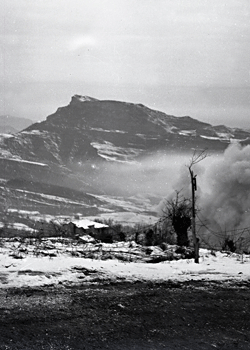 “They arrive faster than I can use them or have them developed. So once upon a time (censor won’t let me say when) I started to take a little trip up forward in my trusty little jeep. And I thought, Well here’s a chance to use up a few of those films & take a few good pictures, so I grab up my camera & set off. When we got up to where I could get a good picture I jumped out of the jeep, took a picture & climbed back in. We went on our way about a hundred yards and a ‘big one’ hit the road about fifty yards ahead of us, nearly blowing one side off a house near-by. I looked at my driver and he looked at me. Then I reached over & patted that camera very very fondly as we drove through the smoke & dust. It was the only time I had taken a camera along or had ever paused on that trip.”
“They arrive faster than I can use them or have them developed. So once upon a time (censor won’t let me say when) I started to take a little trip up forward in my trusty little jeep. And I thought, Well here’s a chance to use up a few of those films & take a few good pictures, so I grab up my camera & set off. When we got up to where I could get a good picture I jumped out of the jeep, took a picture & climbed back in. We went on our way about a hundred yards and a ‘big one’ hit the road about fifty yards ahead of us, nearly blowing one side off a house near-by. I looked at my driver and he looked at me. Then I reached over & patted that camera very very fondly as we drove through the smoke & dust. It was the only time I had taken a camera along or had ever paused on that trip.”
The picture on left is of Monte Adone (Mount Adonis) that saved Captain Newton’s life in December 1944.
Captain Newton became the 805th Tank Destroyer Battalion S-2 (intelligence) on January 6, 1945 and also began pulling double duty as acting S-3 (operations officer) beginning on or around January 11, 1945. (Existing documentation isn’t clear but he may have dropped the S-2 position but retained the S-3 position for a period of time early that year.)
He remarked in a letter to his family that the new position “increases my life expectancy more than somewhat.” Despite the new position, he was in several more engagements. Newton earned a Bronze Star Medal for his actions on April 23, 1945. According to the medal citation, he was visiting his old company, Company “A”, “which was a part of a task force driving towards the Po River.” The citation (which referred to him as a major, though he was a captain when the action occurred) stated:
“Throughout the afternoon, Major NEWTON was continuously at or near the head of the column. On many occasions he dismounted and searched out enemy troops from buildings and fields. At one point, near Magnacavell[o], the force ran into sudden determined resistance and the leading tank, loaded with infantry, was knocked out by bazooka fire. Under intense small arms fire and intermittent self-propelled artillery fire, Major NEWTON supervised the evacuation of the wounded men and simultaneously pointed out targets to an armored car which took up position to return the fire.”
On May 18, 1945 he was promoted to major and became the 805th’s executive officer. Even though the war was winding down in the spring of 1945, an April 30, 1945 letter to his mother recorded two more close calls. Regarding the first, he wrote:
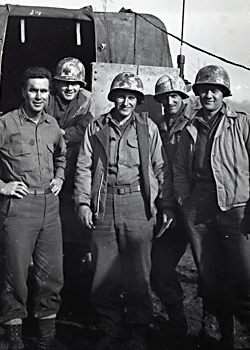
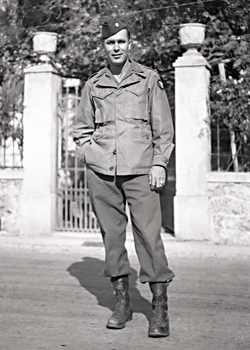
On left is Captain Newton (far left) in December 1944, with four enlisted members of the 805th Tank Destroyer Battalion (Hoffman, Stoner, Engleman, and Fuller). On right is Newton at Lake Garda, Italy, in May of 1945.
“I’m still in the best of health and spirits. Not a scratch as yet. Yesterday, however, a radio message stopped me and [805th C.O., Major Harry N.] Carruthers just 400 yds short of an ambush which got two jeeps that passed us up.”
The other incident apparently happened sometime before (though apparently close enough to the end of the war that German morale was low):
“Once- another guy (a Major) and I jumped out of our vehicles, ran into a farm yard & gathered up about six Krauts. When he stepped around a corner and I heard some shooting so I ran around behind him. He was firing into an orchard so with my pistol (which seemed woefully insufficient) I walked into the orchard with him and as we went along one German at a time would stand up in his fox hole and surrender. We got about five more like that — any one of whom could have cooled us both off if they had tried.
“It was then I thought — what the hell am I doing here!! I’m not a doughboy. This is for the infantry. Then I thought about you and had to laugh when I remembered the way you used to worry when I stayed out past midnite.”
After the war, Major Newton returned to Camp Hood with the 805th and was its final C.O. prior to the unit being inactivated on November 2, 1945. On November 14, 1945, he went on terminal leave and left active duty effective March 16, 1946. His discharge indicates that he was serving with the 804th Tank Destoryer Battalion at the time of his discharge. Major Newton remained in the reserves until April 1956.
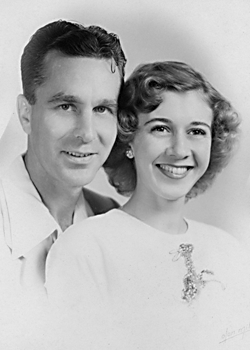
After the war, Newton owned and operated a tourist court (motel). He became a teacher at Ferriday High School in 1948, teaching English, journalism, and speech. On June 29, 1947, Newton married Sue Dale Aldrich (1925–1998) in Vidalia, Louisiana. The couple had one daughter. Baker D. Newton died on April 12, 1961, aged 42. Newton and Sue are shown in the photo on left.
Thank you to Lowell Silverman for his work and to the Baker D. Newton family for providing the photos except as otherwise noted.
